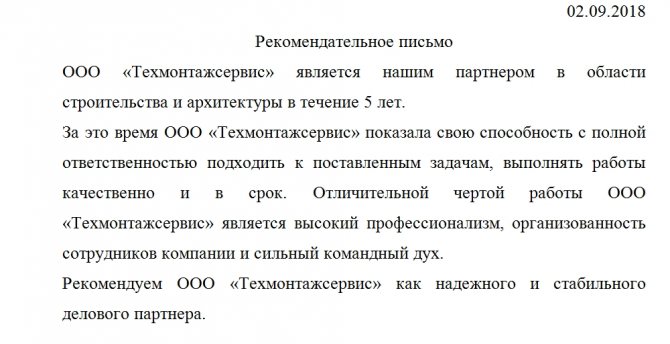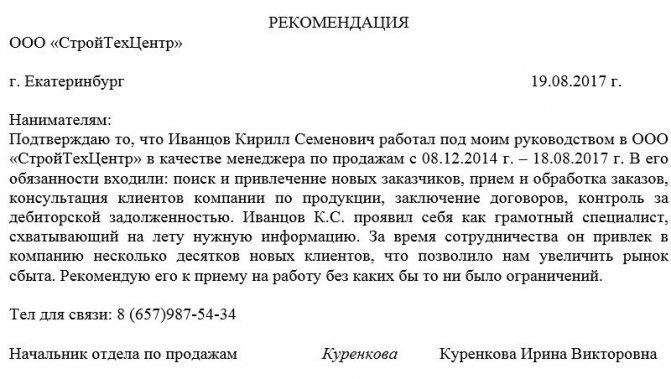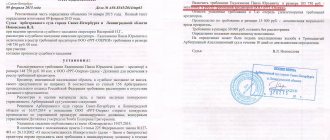07/20/2015 22 289 0 Reading time: 11 min. Rating:
Author
: Konstantin Bely
Today we will talk about one quite necessary and useful thing when looking for a job - a letter of recommendation . Let's look at what this document is, where and from whom you can get it, when you should take it and when not, and how recommendations from a previous employer can help you find a job. We will also consider a typical example (sample) of a letter of recommendation.
Why do you need a recommendation?
A recommendation , or, as it is also called, a letter of recommendation , is a type of document that describes a person’s professional qualities.
This includes:
- information about his skills, ability to cope with assigned tasks,
- communicate with work colleagues, customers, partners,
- ability to learn,
- achievements, successes and similar information.
Sometimes the personal qualities of a former employee are included, but only those that are directly related to the work functions performed.
A recommendation often allows people to find a good, well-paid job in a relatively short period of time, provided, of course, that it is positive.
Who to choose as a counterparty
In order to provide what the bank wants, it is not necessary to conduct a survey among all counterparties with whom the organization has ever dealt. You can select several, guided by the following principles:
- The recommending counterparty is serviced by the same bank to which the application is submitted (and which sent the request for a letter of recommendation). This way, bank employees have the opportunity to verify the recommender’s responsible attitude in financial matters and monitor the movement of his funds under their jurisdiction.
- The recommender has worked extensively and for a long time with the organization. There are no problems, delays, litigation or other “adventures” with him. Still, the timing of cooperation plays a big role in proving a responsible approach to business.
- The counterparty is known, is in good standing with banks, and has no problems concluding transactions. In principle, any large organization that has established a good reputation will do.
If there are no counterparties with such characteristics, then you will have to choose from what is available.
It is worth noting that if there is insufficient support from counterparties or if there is no response to a request for a letter of recommendation from a counterparty, the bank has the right to refuse service to its client and suspend ongoing operations. So you need to be responsible when requesting any documentation.
Who makes the recommendation?
A letter of recommendation is always written on behalf of the previous employer.
Moreover, the document is usually drawn up directly by the former immediate supervisor, for example, the head of a structural unit, department, workshop, or site.
Sometimes the formation of recommendations falls on the shoulders of a human resources specialist, the secretary of the organization, or the director himself (in small firms). In any case, this should be someone who is well acquainted with the person in need of a recommendation, or at least enough to give the most objective, adequate and fair description.
If a recommendation is written by an ordinary employee of an enterprise, it must be signed by an employee in a higher position - only if this condition is met will the recommendation have sufficient weight and credibility in the eyes of the person for whom it is intended.
Components of a document
The letter of recommendation is drawn up in free form. When writing it, you should be guided by the general rules established for business correspondence. At the top, the details of the counterparty are written down (it is best to fill it out on a specialized form of this organization), as well as the date. Without indicating the latter, the bank may not accept the document, since it needs fresh letters of recommendation (this is implied during the request, although it may not be indicated in its text itself).
The main thing that interests employees of a banking organization is how much they should trust a particular current or potential client. So it is advisable to address the following points in the recommendation:
- Details and names of both organizations.
- Are the companies counterparties to each other?
- An agreement concluded between organizations. Its number and date of signing are indicated.
- How long have the companies been cooperating?
- Were there any irresponsible steps or complaints on the part of the recommended person (since this is a letter of recommendation, it is assumed by default that there were none).
- Whether the counterparty fulfilled its debt obligations, if such arose between the counterparties.
The paper ends with the signature of the head of the recommending counterparty and the date. If possible, a “live” seal is placed. This touch adds weight to the recommendation. Although since 2014, attitudes towards the press have changed significantly.

Is an employer required to give a recommendation to an employee?
It is not written anywhere in Russian labor legislation that an employer must provide its former employee with any recommendation.
This means that giving or not giving a letter of recommendation to an employee is the exclusive right of the employer, and not his responsibility.
Thus, in order not to lose the opportunity to receive a recommendation, you should maintain good relations with the employer and colleagues - this will not only allow you to receive the necessary document in a timely manner, but also to some extent guarantee the presence of positive reviews in it.
What is a letter of recommendation and what does it consist of?
This letter is a written assessment of the job applicant's business and personal abilities that are important to a future employer.
The document contains the following information:
- Details of the applicant showing full name. and the period of employment with the employer who signed the document.
- List of specific achievements during work at the enterprise.
- Individual abilities of the applicant.
- The correspondence between the noted skills and the professionalism of the sought vacancy is noted.
- The sufficiency of professionalism and characteristic qualities of the applicant for a job, project, research, etc. is displayed.
- The contacts of the recommender are displayed, with confirmation of the readiness of confirmation of the written document.
The approach to choosing the person providing the recommendation is an important point. The guarantor must work in a higher position than the recommended one (in some cases it may be a colleague).
In essence, a letter of recommendation refers to an ordinary business document. Therefore, its design must comply with the rules of business official letters.
Note. The applicant can only ask to write a letter of recommendation for himself, and not demand it.
, doc
How to write a letter of recommendation
Since the law does not require employers to write letters of recommendation to their employees, this means that there is no unified template for them. That is, representatives of enterprises and organizations can draw up a document in any form.
It is important to observe only a few conditions, in particular, that in its form and structure the recommendation complies with the norms of office work, and in its content and text - with the rules of the Russian language. The document should be quite succinct and concise, strictly to the essence of the issue, without vague formulations, special terms and rude expressions.
The recommendation must include:
- name of the employing organization on behalf of which the document is drawn up;
- position and full name of the person who directly makes the recommendation;
- the characteristic itself - here you need to indicate only the business and professional qualities of the employee, his successes in the workplace, etc.
- information about the reasons for which the person was fired from this place of work.
In a recommendation, it is permissible to give wishes to the future employer about under what conditions and in what jobs it is best to use the work of a given applicant.
If desired, you can attach any additional documents to the recommendation: copies of certificates of achievements, victories, etc.

Help me, boss! Rules for writing letters of recommendation
The letters of an intelligent person reflect the character of those to whom they are addressed. – Georg Christoph Lichtenberg
Leslie Witt and Elizaveta K. Levina (April 2006)
Sooner or later, at a certain stage of your career, your subordinate, colleague, or friend may ask you to write a letter of recommendation. Just like a resume, there is a template for writing a letter of recommendation. Here you will find tips on how to correctly approach the issue of writing a letter of recommendation, what it needs to cover and take into account.
What does a good recommendation mean?
A letter of recommendation is a written confirmation of your professional skills and achievements. The letter reveals the employee’s character, experience, strengths and weaknesses, and most importantly, future potential. The employer is not interested in knowing whether you like Chinese cuisine, whether you have collected stamps since childhood, or whether you play sports. What he really looks for in a potential employee is honesty, reliability, responsibility, intelligence, enthusiasm and a desire to grow and develop. A good letter of recommendation answers all of these questions in a few sentences.
Nota bene
to the manager: protect yourself!
Remember that when you make a recommendation to an employee, you are putting your reputation on the line.
If you undeservedly praise an employee and wholeheartedly recommend him to another company, new employer If you don’t know the employee well, this can be corrected!
The easiest way to write a letter of recommendation is to someone who regularly interacts with this employee at work and knows him well. Sometimes a person is afraid that his immediate supervisor will not give him the best recommendations, and tries to make this request to a senior manager. If you feel that you cannot give an objective recommendation, ask to write a letter to the employee's immediate supervisor, a manager who knows him better.
If you know that this is a good, worthy employee and would like to help him, conduct a short interview with the person, find out what you need to pay attention to, and ask about his future career plans. This information will help you when composing your letter.
Letter of recommendation – presentation of your company
In the letter, you not only talk about your subordinate, but also introduce yourself as an employer. This is a business document that must be drawn up according to appropriate standards. Under no circumstances write a letter of recommendation by hand - this will only discredit your employee in the eyes of a potential employer, and will also indicate that you yourself do not take this person seriously enough and do not respect the trust placed in you.
Set aside time in your work schedule when you can calmly collect your thoughts and get down to business in detail. Be aware of the importance of this document for the person who has approached you with a request, and do not write a letter of recommendation on the fly.
Start with a list
Letters of recommendation serve to provide additional information about the applicant - about how he studied, worked, or did something else. It should present an overall picture of the employee's personality, experience, strengths, potential and skills.
If you don't know where to start writing a letter, it's useful to start by compiling a list of keywords and phrases related to the employee's achievements and qualities. Such a list will help you avoid abstract phrases and metaphorical formulations. All you need to do is clearly state your position and provide evidence.
Organize your keywords and phrases into categories:
1) Professional skills:
Does the employee have the competencies necessary for his position? Can he do the job efficiently and on time? How well does he know his professional field? Does the manager know how to make decisions quickly and constructively?
2) Personal characteristics:
How does the employee develop relationships in the team? Does he have a sense of humor? Does he have an analytical mind? How stress-resistant is a person? Is this person a leader?
3) Successes and achievements
Think through two or three achievements of the employee during the time he worked under your leadership.
4) Weaknesses
What should a person pay attention to in order to develop further in their career? Does a person know how to learn from his past mistakes?
5) Potential
What do you think this employee can achieve?
Structure
The letter, as a rule, does not exceed one page in length (5-7 paragraphs) and consists of three parts: introduction, main part and conclusion.
Introduction
Start by determining in what capacity and for how long you have known the person you are recommending. If the person is your employee, include how long they have been with the company, their responsibilities, and any significant projects they have developed or completed. You can add a couple of lines about the company itself and its scope of activity.
The final sentence of the introduction can summarize and express your general opinion about the recommended employee.
Main part
In the main part, you give a more detailed description of the person in terms of his professional qualities. Describe his ability to cope with certain tasks and list his main achievements. What strengths and weaknesses of the recommended employee are demonstrated at work? What impression does he make when communicating and interacting with other people?
It is most convenient to indicate some quality and confirm it with facts, telling a story of how it manifests itself in practice. For example, you note that Alexey has an analytical mind and a creative approach to business, and tell how he managed to come up with a way to optimize the procedure for delivering goods in your company. Take two or three main characteristics.
To create a clearer picture, characterize the person in terms of his personal qualities and behavior. Did he show himself as a responsible, polite, friendly person or as a lazy, intractable, unfriendly, sarcastic person?
Conclusion
Mention the employee's plans for the future and why you think this is the right path forward. Write why you recommend this person, what contribution he could make to the company where he will go to work. Finally, you can indicate to what extent you recommend the employee for the desired position: strongly, with some reservations, do not recommend.
At the end of the letter, provide your contact information and offer to contact you if the recipient wants additional information.
Don't forget to place the letter on company letterhead, stamp it and sign it.
On a note
The letter is not about you and your company, but about the employee. Information should be presented professionally and openly, without unnecessary arguments, especially unflattering ones, addressed to the employee. Try to reflect the best sides of a person, understand him, see his potential, help him find a good job. This letter gives you the power to influence the future fate of a person, so writing it must be approached with the utmost seriousness.
What should not be written in recommendations
Despite the fact that drawing up a recommendation is entirely up to the employer, when writing it you should adhere to certain rules and avoid certain things.
In particular, you need to try not to give negative, unsubstantiated reviews (i.e., writing such, of course, is not forbidden, but only if there is evidence and confirmation of this, for example, written evidence of disciplinary sanctions, etc.), but it should be borne in mind that such a document is unlikely to ever be used for its intended purpose.
The recommendation should not contain unreliable, unverified or deliberately false information - if such facts are revealed, the reputation of not only the person to whom the document was issued, but also the one who issued it will suffer.
Applications
Copies of the agreements specified in the letter may be attached as the basis for assurances. The larger the amounts and the longer the relationship, the better. You should also not hide anything from bank employees. Perhaps a change in wording will suffice.
For example, if there were some minor complaints during the interaction between counterparties, then it is worth writing in the letter that no major complaints were identified under any of the contracts. On the one hand, this is a positive characteristic, on the other hand, the fact of minor complaints is not hidden.
In general, a sample letter of recommendation to a bank from a counterparty, attached at the top of the text, is the best option. It can be edited to suit a specific situation and the nature of interaction between counterparties. All the main points will be properly described.
Sample recommendation from previous job
As a sample, in the form of a letter of recommendation for an employee (example below), you can express regrets about the loss of a valuable employee and write wishes for a successful career.
- At the end, the date of drawing up the letter and the signature of the manager are indicated. The letter must be signed by the employee’s immediate supervisor, although recently these powers are increasingly being transferred to HR managers.
- Errors The letter of recommendation must be on a special form for a letter of recommendation to an employee (you can download it above) and be effective and convincing. Very often, an incorrectly compiled and written recommendation does not help, but harms the candidate. To make a letter of recommendation a plus for your resume, you need to take a job recommendation as a sample (example below) and avoid the following mistakes:
- You should not write a recommendation without reading the vacancy.
Maria Petrovna is characterized by high efficiency, sociability and goodwill. I would especially like to emphasize her ability to get along with the Bank’s clients and resolve emerging issues without conflict. Currently, our bank is undergoing a reorganization of the activities of management personnel, accompanied by a significant reduction in staff, the position held by Ms. Petrova M.P. is being eliminated. The professional skills and personal qualities of Ms. Petrova allow us to recommend her for further work in banking system. The management of Credit Bank hopes that the acquired work experience will allow Maria Petrovna to be a sought-after specialist and wishes her further success in her professional field. Director of the Moscow branch of CB "Credit Bank" Nikolaev Nikolay SergeevichSignature. Seal. Date of.










